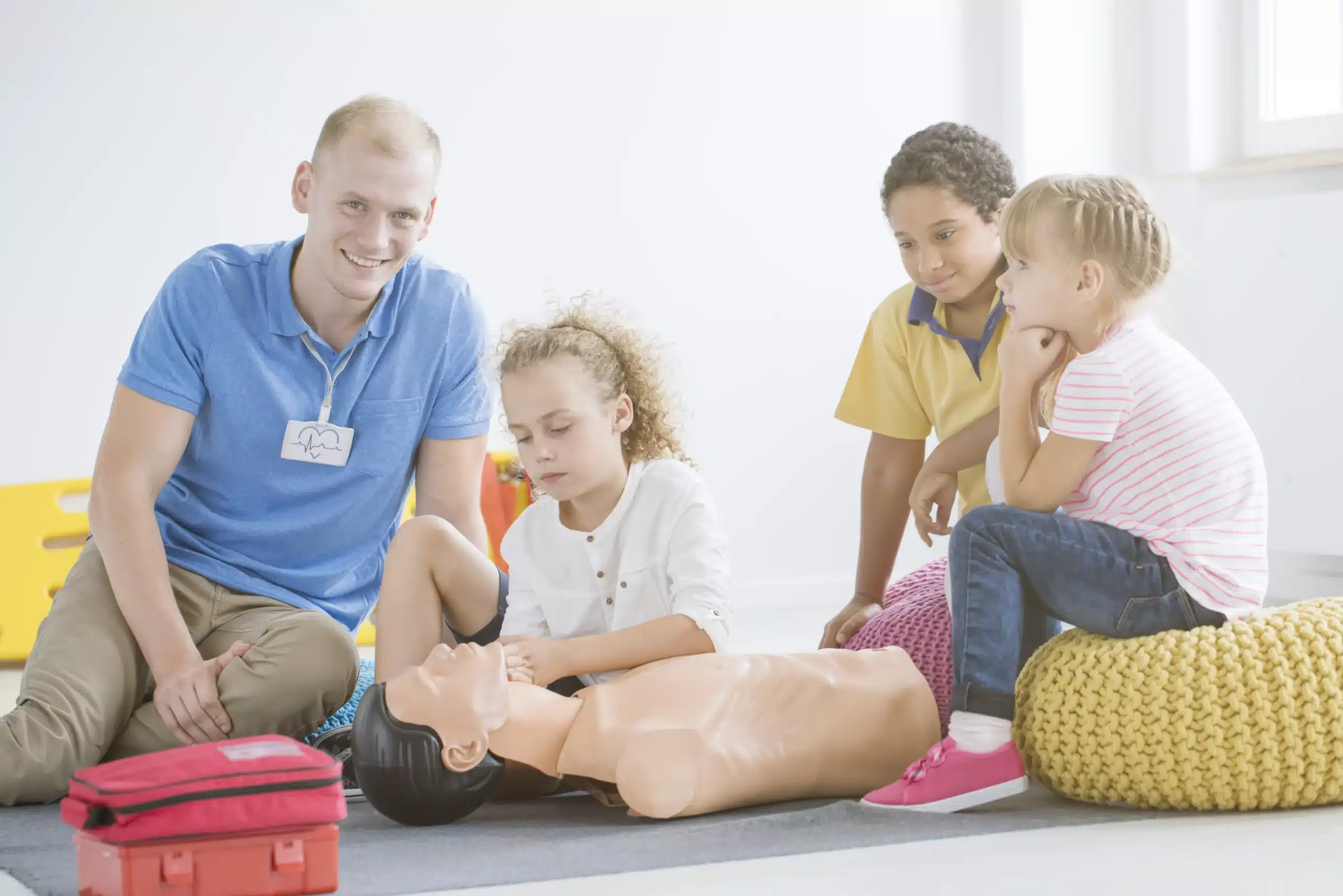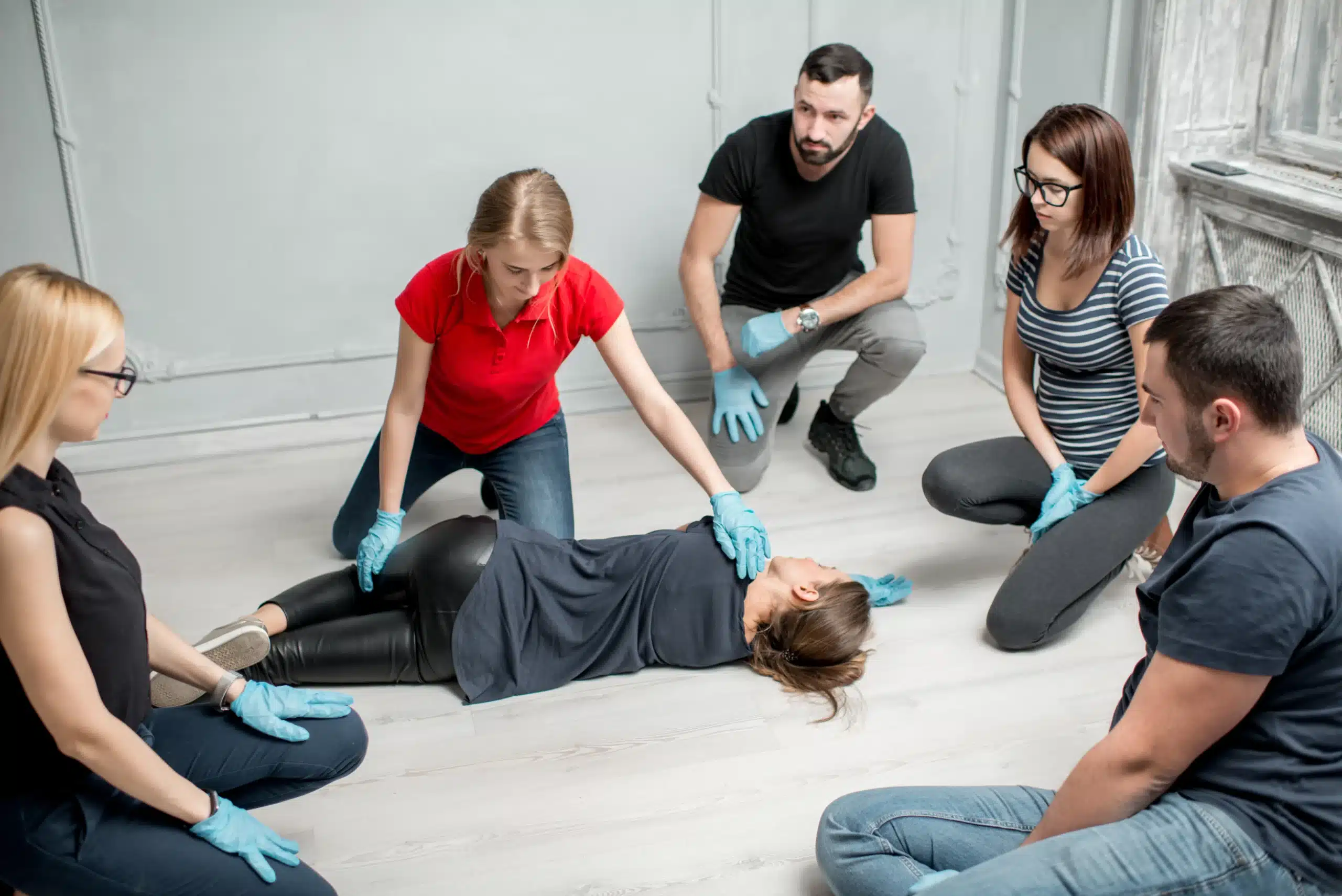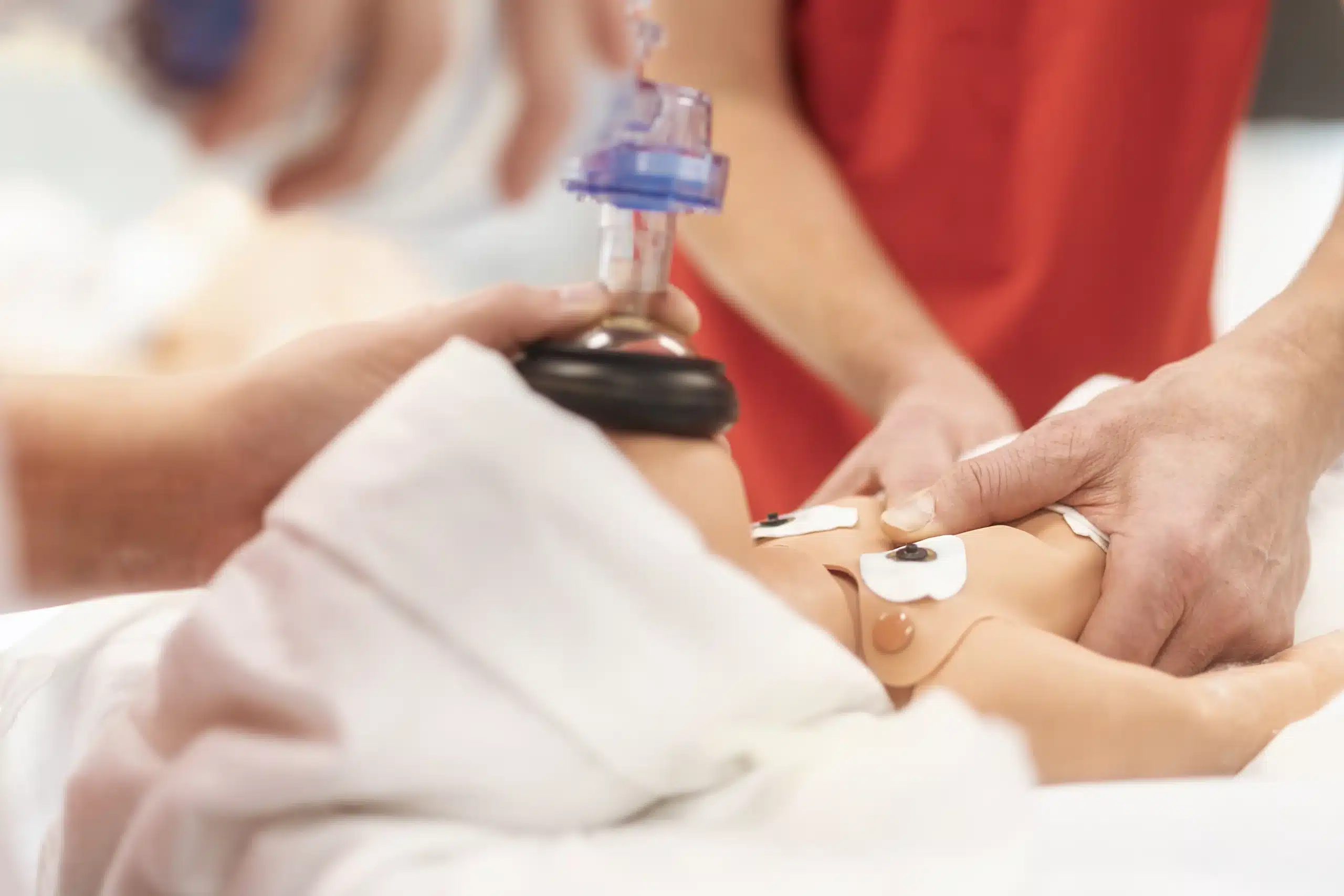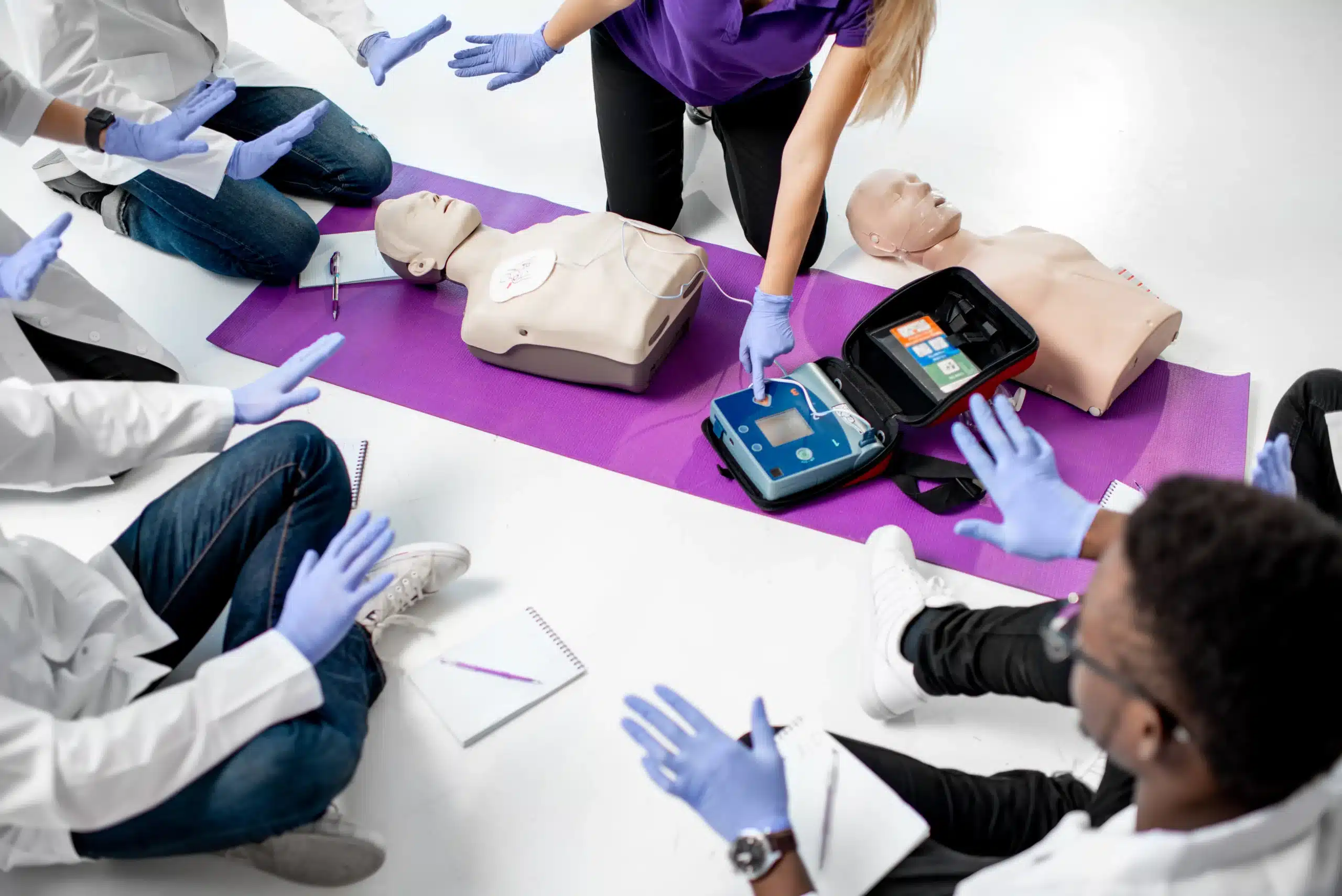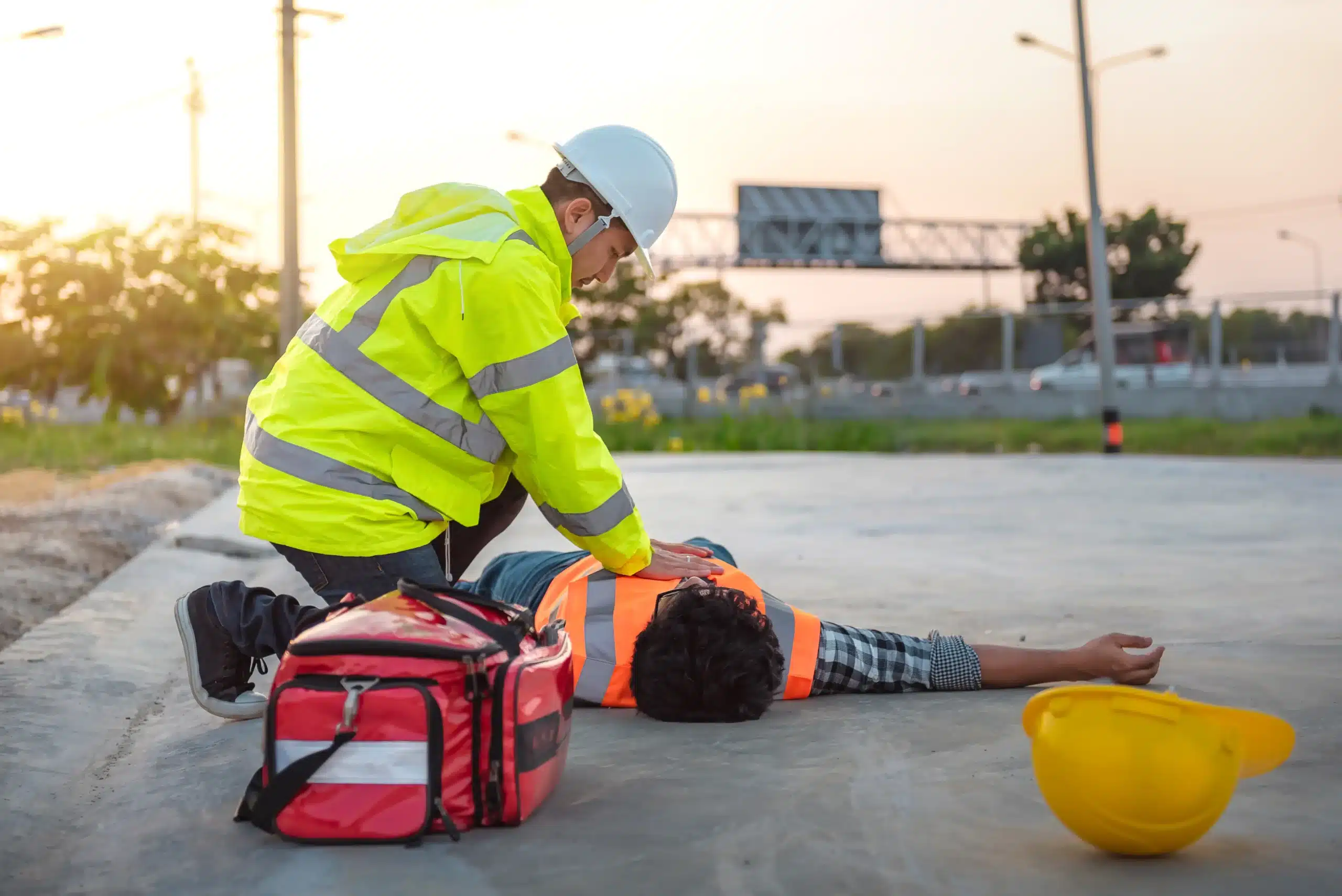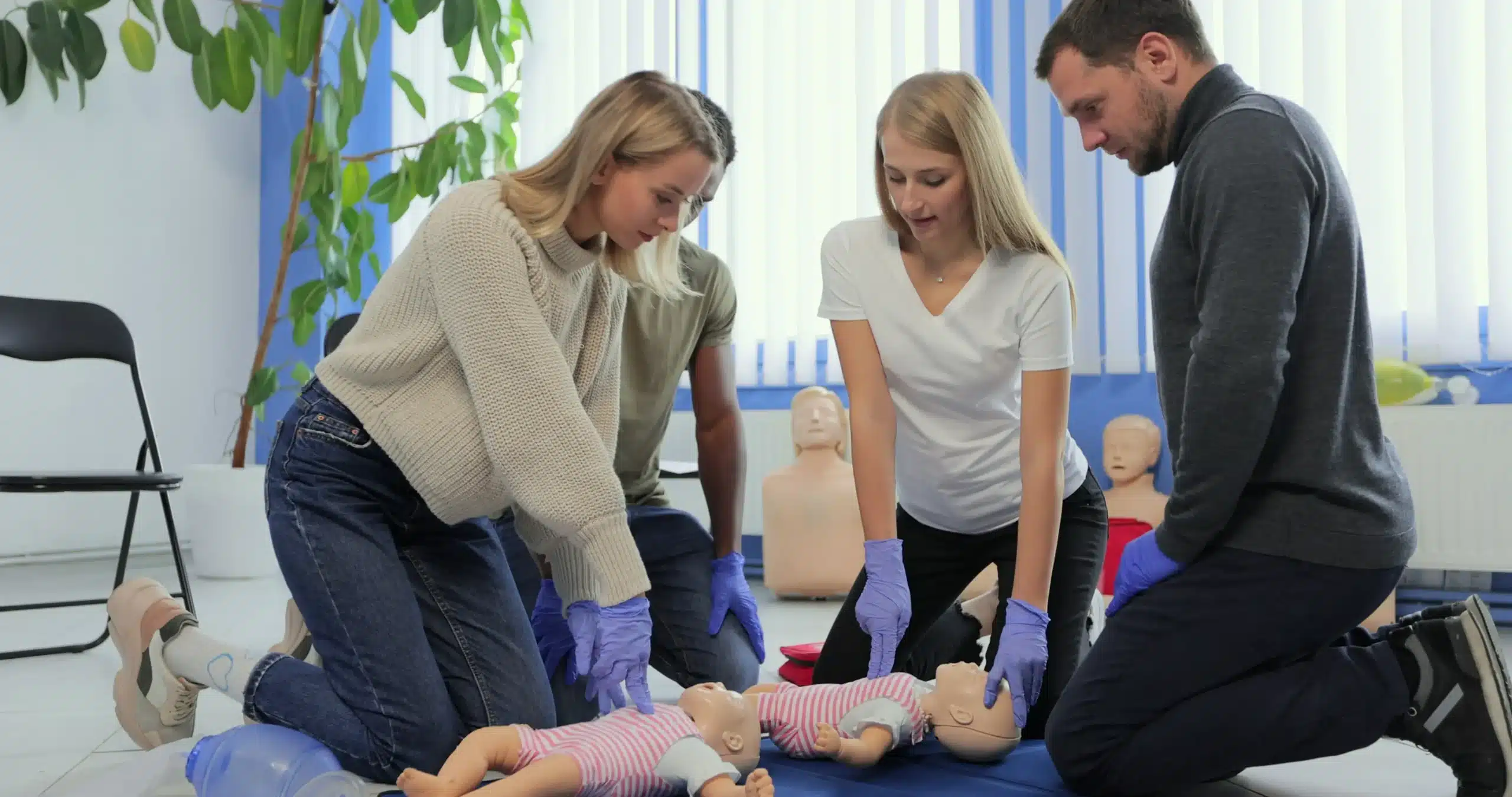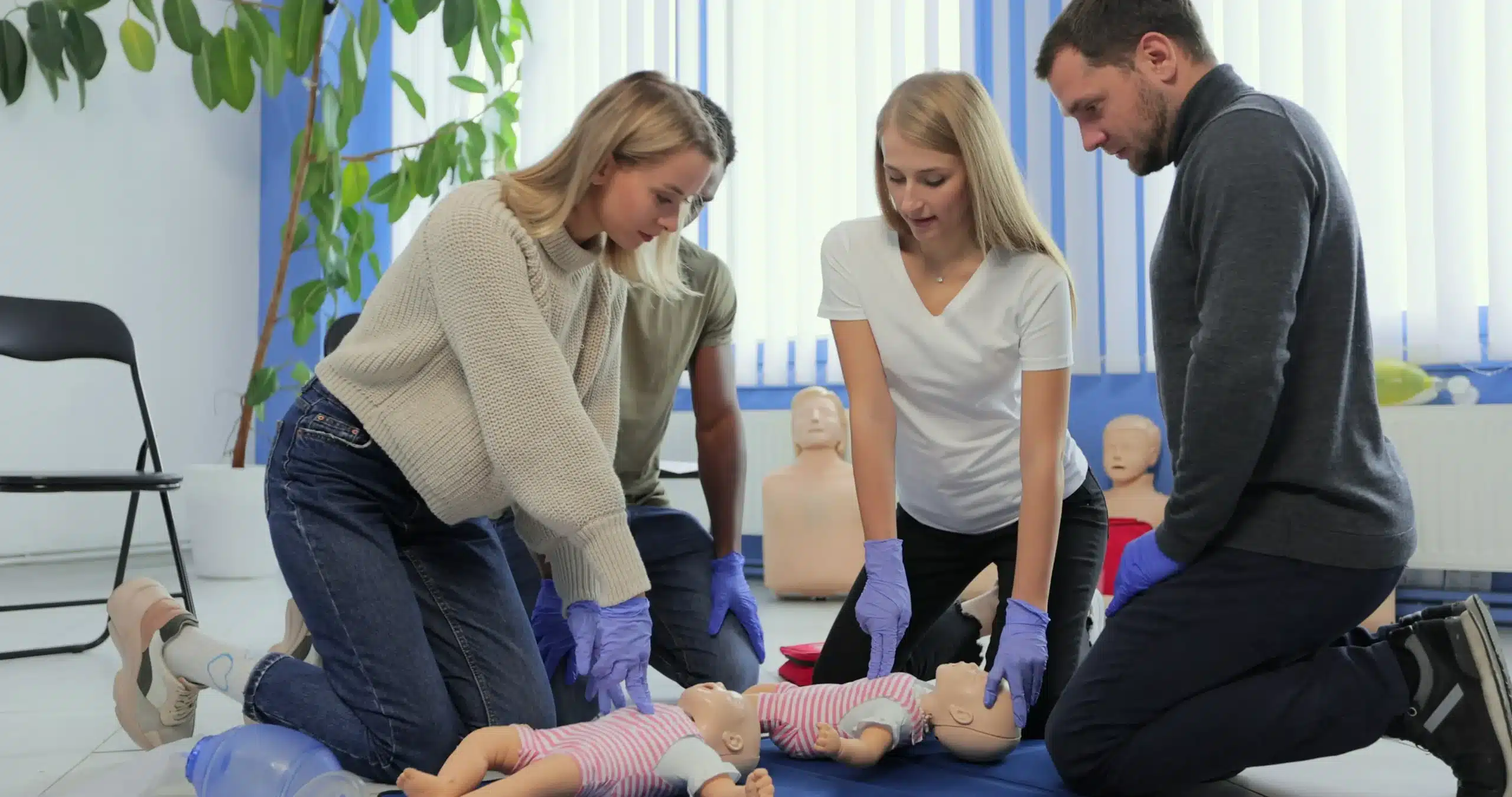In the vibrant city of Oakland, being prepared for emergencies can make all the difference. This guide is your go-to resource for CPR and first-aid training in Oakland, offering valuable insights into the various certifications available, the importance of hands-on practice, and how to choose the right training provider. We’ll delve into the specifics of BLS, ACLS, PALS, and NRP certifications, discuss the costs and value of training, and explore the qualifications of expert instructors. Whether you’re a medical professional, a parent, or simply a concerned citizen, learning CPR and first aid can empower you to respond confidently in critical situations.
Key Takeaways
- CPR and first aid training empowers you to respond effectively to emergencies: Whether you’re a healthcare provider or a concerned citizen, these skills equip you to handle situations ranging from minor injuries to life-threatening events. Find a course in Oakland that suits your specific needs.
- Choose a reputable training provider in Oakland: Look for organizations like Safety Training Seminars or the American Red Cross that offer certified instructors, comprehensive curriculums, and convenient schedules. Consider factors like cost, location, and class format.
- Regular practice and recertification are key: Like any skill, CPR and first aid require ongoing practice to maintain proficiency. Ensure your certification stays current by taking refresher courses and regularly reviewing essential techniques.
What is CPR and First Aid?
CPR, or Cardiopulmonary Resuscitation, is a life-saving technique used when someone’s heart stops beating and they’ve stopped breathing. It involves chest compressions and rescue breaths to circulate oxygenated blood to the brain and other vital organs. Think of it as manually taking over the functions of the heart and lungs. Learning CPR equips you to respond effectively during critical moments before professional help arrives.
First aid covers a much broader spectrum of immediate care for various injuries and illnesses. This can range from treating minor scrapes and burns to managing more serious situations like choking or allergic reactions. First aid knowledge empowers you to provide initial support and stabilize someone until paramedics or other medical professionals take over. While CPR is a specific skill within first aid, understanding both is essential for handling emergencies effectively. It’s about being prepared to help in any situation, big or small.
CPR and First Aid Classes in Oakland
CPR and first aid training empowers you to respond effectively during medical emergencies. Whether you’re a healthcare professional, a childcare provider, or simply someone who wants to be prepared, Oakland offers various certification courses to meet your needs. Let’s explore some of the key certifications available.
BLS Certification
BLS (Basic Life Support) certification is a foundational course for healthcare providers. It equips you with the skills to manage cardiopulmonary arrest and other respiratory emergencies. Training covers high-quality CPR for adults, children, and infants, along with AED (Automated External Defibrillator) use and relief of choking. This BLS certification provides a comprehensive approach to basic life support.
ACLS Training
ACLS (Advanced Cardiovascular Life Support) training builds upon the fundamentals of BLS. It focuses on advanced interventions for adult victims of cardiac arrest and other cardiovascular emergencies. This course is designed for healthcare professionals who are part of resuscitation teams in prehospital or in-hospital settings. ACLS training covers topics such as airway management, rhythm recognition, and pharmacology.
PALS Courses
PALS (Pediatric Advanced Life Support) courses are tailored for healthcare providers who care for infants and children. This specialized training emphasizes the systematic approach to pediatric assessment, resuscitation, and stabilization. PALS certification addresses the unique physiological differences between children and adults in emergency situations.
NRP Certification
NRP (Neonatal Resuscitation Program) certification focuses on the specific needs of newborns requiring resuscitation. This course is essential for healthcare professionals involved in the delivery and immediate care of newborns. NRP certification covers the essential steps of neonatal resuscitation, including airway management, chest compressions, and medication administration.
First Aid Certification
First aid certification provides the skills and knowledge to manage a wide range of injuries and illnesses, from minor cuts and burns to more serious conditions like fractures and allergic reactions. This training is valuable for anyone who wants to be prepared for everyday emergencies. Consider first aid training to learn how to respond confidently in various situations.
Top CPR and First Aid Training Providers in Oakland
Finding the right CPR and first aid training provider is crucial for receiving quality instruction and proper certification. Here are some of the leading training centers in Oakland:
Safety Training Seminars
Safety Training Seminars offers a comprehensive range of American Heart Association certification courses, including BLS, ACLS, PALS, and NRP certification. They are known for their commitment to customer service, competitive pricing, and convenient class schedules. They also offer discounts for group classes, making them a great option for workplaces or community groups. As an authorized training center, certifications earned through Safety Training Seminars are recognized nationwide. Their focus extends beyond basic CPR and first aid, equipping participants with the skills to handle various medical emergencies.
American Red Cross
The American Red Cross is a well-established provider of CPR and first aid training, offering a variety of courses in Oakland and throughout the Bay Area. The Red Cross’s reputation for comprehensive training makes them a reliable choice for individuals and organizations. Their courses are designed to be accessible and convenient, often requiring just a few hours to complete.
American Heart Association Training Centers
Several authorized American Heart Association Training Centers operate in Oakland, providing high-quality CPR, BLS, ACLS, and PALS courses. These training centers adhere to the AHA’s rigorous standards, ensuring participants receive consistent and up-to-date instruction. Safety Training Seminars, mentioned above, is one such example, offering the AHA’s BLS course among other certifications. Choosing an AHA Training Center guarantees your certification will be widely accepted.
Oakland Fire Department
The Oakland Fire Department may offer CPR and first aid training programs for community members. It’s best to check their official website or contact them directly for the most current information on available courses and schedules. Learning from experienced first responders can provide valuable real-world insights.
CPR Certification Oakland
CPR Certification Oakland focuses specifically on providing American Heart Association BLS CPR classes. They aim to create an engaging learning environment where students develop the confidence to perform CPR effectively. Their specialized approach to BLS training can be a good fit for those seeking a focused and efficient learning experience.
CPR & First Aid Class Costs & Value
Understanding the cost and value of CPR and First Aid training is an important step in choosing the right course. Let’s break down the typical expenses associated with these essential, life-saving skills.
Individual Course Prices
In Oakland, individual course prices vary depending on the certification you need. A standard CPR class typically costs around $65, while a combined CPR and First Aid class is usually around $85. Most classes run for approximately three hours, and your certification will be valid for two years. Remember, investing in these skills means investing in your ability to respond effectively during emergencies.
Combination Packages
If you’re looking for more comprehensive training, combination packages offer excellent value. These packages often bundle certifications like Basic Life Support (BLS) with Healthcare Provider CPR, AED, and First Aid. This option is particularly beneficial for healthcare professionals or anyone wanting a broader skill set in emergency response. Check with your chosen training provider, like Safety Training Seminars, for details on available combination packages.
Group Discounts & Special Offers
Training multiple employees or a large group of friends? Many providers in Oakland, including Safety Training Seminars, offer group discounts and special promotions. Some providers will even conduct on-site training, making it even more convenient and cost-effective. Reach out to training centers directly to discuss group options and tailor a solution that fits your budget and scheduling needs.
Additional Fees
While the initial course fee covers the core training, be aware of potential additional costs. For example, some organizations, like the American Red Cross, may require an extra fee for their online first aid and CPR course to receive a two-year digital certificate that meets OSHA and other regulatory standards. This often involves an in-person skills session within 90 days of completing the online portion. Always clarify the full pricing structure with your chosen provider to avoid surprises. Look for providers with transparent pricing, like Safety Training Seminars, which offers a low price guarantee.
Get Certified: Training and Validation
Steps to Certification
Getting your CPR and First Aid certification is straightforward. You’ll participate in a comprehensive training program covering essential life-saving techniques like CPR, AED usage, and basic first aid. These classes use a hands-on approach, giving you practical experience and the confidence to handle real emergencies. You’ll learn to assess a situation, perform chest compressions, use an AED, and provide initial care for various injuries.
Certification Validity
Your CPR and First Aid certification is valid for two years. This two-year validity is standard practice to ensure your skills and knowledge are current. Emergency response procedures can change, and staying up-to-date is vital for providing effective care.
Renewal Requirements
To keep your certification active, you’ll need to renew it every two years. Renewal involves taking a refresher course to review key concepts and practice essential techniques. This ensures you’re always prepared to respond confidently and effectively in any emergency.
Instructor Qualifications & Course Quality
When your health or the health of a loved one is on the line, you want to know the person providing CPR knows what they’re doing. Choosing a CPR class with qualified instructors is crucial for effective training. Look for courses taught by certified instructors with real-world experience. This section explores the key qualifications to look for when selecting a CPR and First Aid class in Oakland.
Certified Instructor Expertise
Instructors should hold current certifications from reputable organizations like the American Heart Association or the American Red Cross. This ensures they’ve received standardized training and meet specific requirements. Safety Training Seminars offers courses taught by certified instructors who bring their expertise directly to your chosen location in Oakland, providing convenient on-site training. These classes often cover a range of certifications, including Basic Life Support (BLS) and Healthcare Provider CPR, AED, and First Aid, equipping you with comprehensive life-saving skills.
EMS Experience
While formal certifications are essential, real-world experience adds another layer of valuable insight. Instructors with backgrounds in Emergency Medical Services (EMS) often bring a practical understanding that goes beyond the textbook. They can share real-life scenarios and offer practical tips gleaned from their field experience. This practical knowledge can be invaluable in preparing you for real emergencies. CPR and First Aid classes in Oakland cater to diverse audiences, recognizing that these skills are vital for everyone.
Instructor Training & Updates
Medical knowledge and best practices are constantly evolving. It’s important to choose CPR and First Aid classes where instructors stay up-to-date with the latest guidelines and techniques. Look for training providers who emphasize continuing education and require their instructors to participate in regular refresher courses. This commitment to ongoing training ensures you receive the most current and effective instruction, preparing you to respond confidently in any emergency situation. Supplemental resources, like those available through the Red Cross, can reinforce your learning and provide ongoing support.
What Happens in a CPR & First Aid Class?
Want to know what to expect in your CPR and first aid class? Here’s a quick overview of a typical class, from structure and duration to hands-on practice and certification.
Course Structure & Duration
CPR and first aid classes equip you with the skills and knowledge to handle emergencies. You’ll learn basic life support (BLS), including CPR for adults, children, and infants, how to use an automated external defibrillator (AED), and provide first aid for common injuries. Most classes take just a few hours, making them easy to fit into your schedule. Safety Training Seminars offers convenient CPR and first aid classes in Oakland.
Hands-On Practice
CPR and first aid training isn’t just lectures. A significant portion involves hands-on practice with training manikins to build muscle memory and confidence. You’ll practice chest compressions, rescue breaths, and other essential techniques, preparing you to act quickly in a real emergency. Some providers, like Oakland CPR, even bring the equipment to you.
Assessment & Certification
At the end of the class, you’ll typically demonstrate your understanding and skills through an assessment. Upon successful completion, you’ll receive certification, usually valid for two years. Recertification is straightforward, ensuring your skills stay sharp. You can find reviews for CPR Certification Oakland at Trustindex.io.
Choose the Right CPR & First Aid Course
Finding the right CPR and First Aid class can feel overwhelming, but focusing on a few key factors simplifies the process. Think about your specific needs, preferred learning style, and what other students are saying about different training providers.
Assess Your Needs
Before signing up for a class, consider why you want CPR and First Aid training. Are you a healthcare professional who needs BLS Certification? Do you work with children and require PALS Certification? Or are you a parent, teacher, or community member looking for a general CPR and First Aid course? CPR Certification Oakland offers a range of courses designed for different needs, so identifying yours upfront will help you choose wisely.
Online vs. In-Person
CPR and First Aid courses are available in several formats. Online learning offers flexibility, allowing you to complete the coursework at your own pace. However, in-person classes provide hands-on practice and direct interaction with an instructor. The American Red Cross offers both options, so consider your learning style and schedule when making your decision. If you thrive in a structured environment and value hands-on learning, an in-person class might be a better fit. If you need more flexibility, an online course could be ideal.
Reviews & Testimonials
Once you’ve narrowed down your options, reading reviews and testimonials offers valuable insights. Past participants often share their experiences, highlighting the strengths and weaknesses of different courses and instructors. Sites like Trustindex.io and Yelp can be great resources for finding honest feedback. Look for comments about the instructor’s teaching style, the quality of the materials, and the overall learning experience. This extra research can give you confidence that you’re choosing a reputable provider and a course that meets your expectations.
Maintain Your CPR & First Aid Skills
Learning CPR and first aid is a great first step, but staying sharp on those skills is essential. Like any skill, regular practice helps you respond quickly and effectively during a real emergency.
Practice Regularly
Think of it like learning a new language—if you don’t use it, you lose it. The same idea applies to CPR. Regular practice is essential to retain the skills you learned in your first aid training. Set aside time to review the steps, even if it’s just mentally running through different scenarios or practicing compressions and breaths on a mannequin. This consistent reinforcement will build your muscle memory and confidence, ensuring you’re ready to act when needed.
Refresher Courses
Even with regular practice, guidelines and best practices can evolve. Consider taking a refresher course every couple of years. These courses not only update your knowledge but also provide valuable feedback and reinforce proper techniques. Many people find this recurring training reinforces the importance of these life-saving skills and increases their confidence.
Real-World Application
While we hope you never have to use your CPR and first aid skills, being prepared can truly make all the difference. CPR and first-aid training equips you to respond effectively in various emergencies, from a minor cut to a life-threatening cardiac event. Knowing you have the skills to help can empower you to act quickly and confidently in a crisis.
Why CPR & First Aid Training Matters in Oakland
Knowing CPR and first aid empowers you to handle emergencies effectively, and it’s especially relevant in a bustling city like Oakland. From everyday mishaps to more serious incidents, these skills can make a real difference in the well-being of your family, friends, coworkers, and community. Let’s explore why these skills are so crucial in Oakland.
Local Emergency Response
Oakland, like any city, experiences medical emergencies. Response times from professional medical personnel can vary, and in those critical minutes, someone trained in CPR and first aid can provide immediate assistance. This quick action can stabilize a person’s condition and significantly improve their chances of survival. CPR and first aid training equips residents to be valuable first responders in their own neighborhoods, bridging the gap until professional help arrives.
Community Health Impact
Learning CPR and first aid isn’t just about responding to major emergencies; it’s about building a safer and healthier community. These skills empower individuals to handle a wide range of situations, from minor cuts and burns to more serious incidents like choking or allergic reactions. By learning these skills, you contribute to a network of prepared individuals ready to assist others. This creates a ripple effect, fostering a culture of preparedness and resilience within the community.
Workplace Safety
Many workplaces, especially those in healthcare, childcare, or fitness, require CPR and first aid certifications. Even if it’s not mandatory, having these skills enhances workplace safety and can be a valuable asset. This preparedness not only protects employees but also creates a more secure and productive work environment.
Related Articles
- The Importance of Workplace CPR & First-Aid Training
- CPR Certification in Oakland: Your Guide – Oakland CPR Classes
- BLS ACLS PALS Courses in Oakland: Your Complete Guide – Oakland CPR Classes
- CPR & First-aid Classes in Oakland, CA – Oakland CPR Classes
- Why CPR is Crucial in Healthcare
Frequently Asked Questions
How long does it take to get CPR certified?
CPR and first aid certification courses can often be completed in a single day, typically ranging from 3-8 hours depending on the specific course and provider. Combination courses, covering both CPR and first aid, might take a bit longer.
What’s the difference between CPR and first aid?
CPR focuses specifically on life-saving techniques for someone whose heart has stopped beating or who has stopped breathing. First aid encompasses a broader range of skills for treating various injuries and illnesses, from minor cuts to more serious conditions. CPR is actually considered a component of first aid.
How much does CPR and first aid training cost in Oakland?
Costs vary depending on the provider and the type of certification. A basic CPR course might cost around $65, while a combined CPR and first aid course could be around $85. Look for providers offering group discounts or combination packages for better value. Always confirm pricing directly with the training center.
How often do I need to renew my CPR certification?
CPR certifications are typically valid for two years. Renewal involves taking a refresher course to ensure your skills and knowledge are up-to-date.
What if I’m nervous about performing CPR in a real emergency?
It’s completely normal to feel apprehensive. High-quality training programs emphasize hands-on practice and build confidence through realistic scenarios. Choose a course with experienced instructors who can address your concerns and create a supportive learning environment. Remember, any action is better than no action, and your training will equip you to make a difference.


